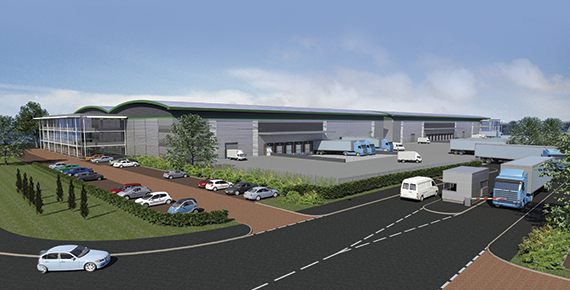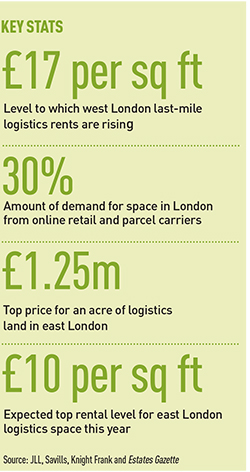 It’s a common scene in London: a few vans parked up in a layby or a car park, maybe a couple of private cars with their doors open. You’ve probably wondered what they were up to. For the dirty minded among you, it isn’t what you thought: they were simply improvising a cross-docked warehouse.
It’s a common scene in London: a few vans parked up in a layby or a car park, maybe a couple of private cars with their doors open. You’ve probably wondered what they were up to. For the dirty minded among you, it isn’t what you thought: they were simply improvising a cross-docked warehouse.
Transferring parcels from one van to another or onto private vehicles ahead of their final household delivery is now believed to be a regular occurrence in London’s open spaces, car parks, laybys and “informally appropriated” land. Why? Because getting a lease on the logistics premises they really need is now hugely expensive, time-consuming and, in some neighbourhoods, impossible. Smaller carriers, or those feeling the acute pressure of supply chain overheads, judge that they have no choice.
Logistics property professionals point the finger of blame squarely at the residential market. They say pressure for residential development over a swathe of industrial sites, big and small, has left the burgeoning last-mile home delivery market stranded. Sites such as Old Oak Common – next to Park Royal, and ideal for industrial use – are now being appropriated for housing. Sites that seemed once to be destined for indefinite industrial use – such as the old Ford plant at Dagenham – are now covered in new homes.
The consequence is rents rising sharply – above £10 per sq ft in the east, around £16 rising this year to £17 per sq ft in the west – and a list of vacant properties or potential sites that shrinks every day. The land-hungry, cross-docked sites preferred by parcels operators – cigar-shaped buildings of about 20,000 sq ft an acre – are the scarcest of the lot.
 An exasperated Dominic Whitfield, director at Savills, says: “Finding cross-docked facilities in London is… well, they are the hen’s teeth of logistics.”
An exasperated Dominic Whitfield, director at Savills, says: “Finding cross-docked facilities in London is… well, they are the hen’s teeth of logistics.”
“If you could find a cross-docked unit in west London it would be around £12 per sq ft – and that needs emphasising. Until recently you could get office blocks for less,” he says. “These are proper prices, and operators like Geopost are said to be paying as much as £11 per sq ft even in locations like Dagenham.”
“The trend is clear: you won’t get a cross-docked unit inside the M25 for less than £11,” he adds.
Developers and landlords, however, are delighted. Paul Weston is head of London markets for Prologis, presiding over a portfolio centred on Hillingdon where it has 800,000 sq ft. His team are on site at the 120,000 sq ft Prologis Dawley Road scheme and will soon begin another 485,000 sq ft at Prologis Park West London.
Weston grumbles that the land supply is getting dangerously low – and could go lower. “In north London we’re facing a situation where development land is under incredible pressure from other uses. In east London there is more land, but we lost a lot of industrial land to the Olympics, and in west London there is now massive pressure on sites such as Old Oak Common – 80-plus acres of industrial land now heading into residential use,” he says.
“How on earth do you supply the London market? London still needs its sandwich makers and its photocopier repair guys, as well as parcel deliveries, and the pressure is on. There is a real need to cherish industrial areas.”
Demand is such that suitable units let before you can say “same-day delivery”. Prologis’s 70,000 sq ft former Citylink unit at Heathrow was recovered, refurbished and re-let (to Amazon) within three months.
Segro director Alan Holland is hoping to push rents further at Park Royal’s 22-acre former Guinness brewery, now re-named Origin. “Hopefully we can nudge them up another 50p-75p per sq ft,” he says. Today they are around £16 per sq ft.
However, Segro is gambling on west London rents being too high for many – making east London a more attractive option.
Segro’s East Plus arrangement with the Greater London Authority opens up 85 acres of development land. The first 200,000 sq ft developments – now in the midst of Segro’s internal approvals process – could begin in the second half of this year. A handful of mid-box units of 40-70,000 sq ft is likely, with last-mile delivery operators as the target audience.
“This could be the development to push east London rents into double figures,” says Holland.
With a London landbank of 100 acres of developable land, Segro is in a strong position.
For potential tenants, things don’t look so much fun. According to those in the know, several parcels operators are re-thinking their strategy in the face of rising property costs.
Solutions under debate include spoke-and-hub depots of 5-10,000 sq ft within the M25, with larger hubs outside. But the downside is increased overheads and the risks of slowness and loss associated with more parcel transfers.
Some suggest cohabitation could be the answer: if a parcels firm can use a site overnight – its peak period – it could share the cost with a compatible daytime operator. But finding a suitable partner will not be easy – and splitting costs and responsibilities could prove to be a nightmare.
Even improvised solutions such as car parks come with barriers – literally. Plenty have height-limiting gates which mean most delivery vans cannot get in.
Multi-storey development could be on the agenda, while click-and-collect could come to the rescue – relieving some of the burden of doorstep delivery. But the most likely compromise solution is simply to move last-mile logistics sites further from London. Reading and the Thames Valley are tipped to be the early beneficiaries of migration from London, but all M25-accessible sites could be in with a shout. Amazon is sourcing chilled food from Weybridge – a sign of things to come.
Simultaneously, rents are rising. JLL director Andy Harding says: “Enfield, stuck at £8.50-£8.75 per sq ft, is now up into double figures, Dagenham is up there too, and in the west, Park Royal will hit £17 per sq ft this year, and the only way is up.”
So what happens next? “I wish I knew,” says Charles Binks, partner at Knight Frank. “Click-and-collect will take some of the strain of household delivery, but the parcel operators are still working it all out.”
With even east London land prices rising to beyond £1.25m an acre, rents are sure to grow even further. Double figures for east London seems inevitable and £17, £18 or even £19 per sq ft can’t be ruled out in the west.
Says Prologis’s Paul Weston: “The idea of having smaller outposts inside the M25, and larger beyond, isn’t a daft one. Amazon seems to be trying something like that because you just can’t get the land for large footprint buildings anywhere outside the east of London, and not everyone wants to go east.”
For the time being, those little huddles of vans and cars in laybys seem a fixture of the London logistics scene. Until either parcel delivery profit margins grow, or overheads shrink, improvised solutions will always have their fans.
• SEE ALSO:











